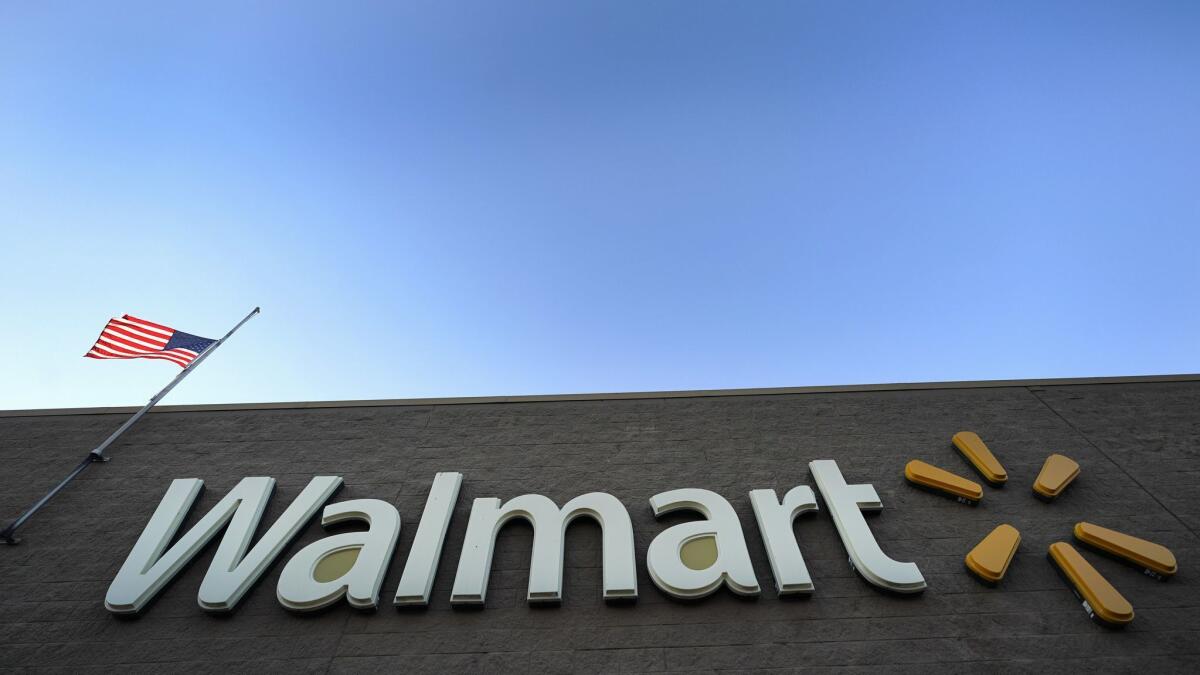Self-driving delivery is coming to Walmart — but not directly to customers

- Share via
Walmart Inc. came to dominate retailing through its mastery of logistics — the complicated choreography of getting goods from farm or factory to the consumer. But even the world’s biggest store doesn’t make money selling its wares online in the U.S., largely because of runaway shipping costs. So Walmart is turning to robots.
On a drizzly morning earlier this month, Walmart’s U.S. chief Greg Foran led reporters to a curbside package pickup kiosk outside its supercenter in Rogers, Ark. Idling there were three Ford delivery vans outfitted with self-driving technology developed by Gatik, a Silicon Valley startup tasked with a trial run aimed at cutting Walmart’s middle-mile shipping costs in half. Going driverless in pursuit of profit is a “no-brainer,” Foran said.
As the buzz about human-carting robo-taxis starts to short-circuit, an unheralded segment of the driverless future is taking shape and showing promise: goods-moving robo-vans. Rather than serving up hot pizza pies or deploying headless robots to carry groceries to the doorstep, robo-vans travel on fixed routes from warehouse to warehouse or to a smaller pickup point, transporting packages to get them closer, but not all the way, to consumers.
This may be the least glamorous part of the driverless delivery business, but the market for these monotonous “middle miles” could reach $1 trillion and may provide the fastest path to prosperity, analysts say.
“This area has the least number of obstacles and the most certain return on invested capital in the near term,” said Mike Ramsey, an analyst with consultant Gartner Inc. “If you’re looking to start a business where you can actually generate revenue, this has fewer barriers than the taxi market.”
Driving the demand is the boom in online shopping that has helped cause a severe shortage of truck drivers that tops 60,000 unfilled long-haul positions, according to the American Trucking Assns. That has sent costs soaring for a job that is among the most dangerous because of the risk of wrecks and long periods spent on the road.
“This middle mile is the most expensive part of the whole supply chain; it’s a huge pain point,” said Gautam Narang, CEO of Gatik, which is attempting to automate Walmart’s “hub and spoke” warehouse system. “This fills a big gap in the market.”
From a technological standpoint, business-to-business, or B2B, delivery is the straightforward counterpoint to the complexities of autonomous ride-hailing and driverless delivery directly to consumers, known as B2C or last-mile. Robo-vans like those being put to the test at Walmart follow fixed routes over and over, reducing the chance of mishaps and increasing their time in service generating revenue. Many of these routes are already established using human drivers today, so there’s little need to map new paths and create infrastructure to load and receive the goods.
Ford Motor Co., testing many forms of driverless delivery, calls these repeatable routes “milk runs,” a throwback term to the days of household dairy delivery.
“Anything on driverless delivery that is a milk run is a good application for autonomy,” said Sherif Marakby, chief executive officer of Ford’s autonomous vehicles unit. “B2C is a complex implementation for autonomy that will come with time, but B2B just makes it easier because you get volume and you can be more predictable.”
The case for robots ferrying packages before people is becoming more compelling as robo-taxis struggle to gain traction. Consumers have grown wary of giving up the wheel, especially after a pedestrian was killed last year by an autonomous Uber Technologies Inc. test car. Waymo, Alphabet Inc.’s driverless unit, initiated limited automated ride-hailing in suburban Phoenix late last year with human “safety drivers” on board. General Motors Co. no longer says it will debut a similar service this year. Instead, CEO Mary Barra now says the rollout will be “gated by safety.”
Driverless delivery also has another big advantage over robo-taxis: no demanding human passengers. “People have more emotions than boxes,” Ford’s Marakby said.
Meanwhile, driverless delivery is already hitting the road. Swedish startup Einride recently began low-speed robo-deliveries on public roads in its home country. It has signed up several Fortune 500 clients, like tire-maker Michelin, plus logistics service provider DB Schenker and German grocer Lidl.
Looking like a Star Wars Imperial Troop Transport on wheels, Einride’s T-Pod trucks are 60% cheaper to build because they lack a passenger compartment. If they get into a jam, they can be remote controlled by humans from a command center. One human monitors the remote controls for 10 trucks. The T-Pods operate in self-driving mode 95% of the time, according to CEO and founder Robert Falck.
Stuffed with payload and no human driver, a T-Pod can operate around the clock and cut shipping costs in half. That’s why Falck says his company is already profitable, though he declines to give specifics.
“There are solid economics behind this and that’s also what the customer realizes,” Falck said. “If you break down the numbers, it’s the best business case out there.”
TuSimple, a San Diego startup valued at $1.1 billion, leads a pack of tech outfits seeking to automate long-haul trucking. The company has a fleet of 50 robot Peterbilt and Navistar trucks that have been transporting commercial loads in Arizona for a year. And while it isn’t profitable yet, it expects to book revenue of more than $1 million a month in the second half of the year.
“If you break down the numbers, it’s the best business case out there.”
In the final two weeks of May, its self-driving big rigs — equipped with cameras that can see more than a half-mile down the road — completed 10 test runs for the U.S. Postal Service of an arduous 1,000-mile stretch from Phoenix to Dallas. Over Memorial Day weekend, the trucks faced howling crosswinds and “mud rain,” a blinding combination of dust, wind and rain. And yet the robo-rigs consistently beat human-driven trucks to the mail depot by as much as two hours.
“We were approaching the edge of our operational design domain,” said Chuck Price, TuSimple’s chief product officer. “But we were able to demonstrate that we can do it much faster, with high consistency and high reliability. So bottom line, it’s more efficient.”
By next year, TuSimple says it will pull the safety driver and engineer it currently has babysitting its rigs and go fully driverless — something no robo-taxi has committed to yet. By 2023 or 2024, the company plans to have “commercially ready” robo-rigs rolling out of a factory of a major truck maker.
That kind of confidence is hard to come by these days among the purveyors of robo-taxis, still struggling to figure out how to navigate the pedestrians, cyclists and unpredictable traffic of chaotic urban environments. Increasingly, the call of the open road and the mundane middle miles between warehouses is proving to be the clearest path to the autonomous future. That’s why big players like Waymo and Tesla Inc. — still working on driverless people haulers — are also developing robo-rigs.
“There’s absolutely a market for this sort of thing,” said Sam Abuelsamid, an analyst with Navigant Research. “People don’t really care much about what goes on behind the scenes to get them the products they want. But the value of all the goods being moved is far more than ride-hailing applications.”
Naughton and Boyle write for Bloomberg.
More to Read
Inside the business of entertainment
The Wide Shot brings you news, analysis and insights on everything from streaming wars to production — and what it all means for the future.
You may occasionally receive promotional content from the Los Angeles Times.








